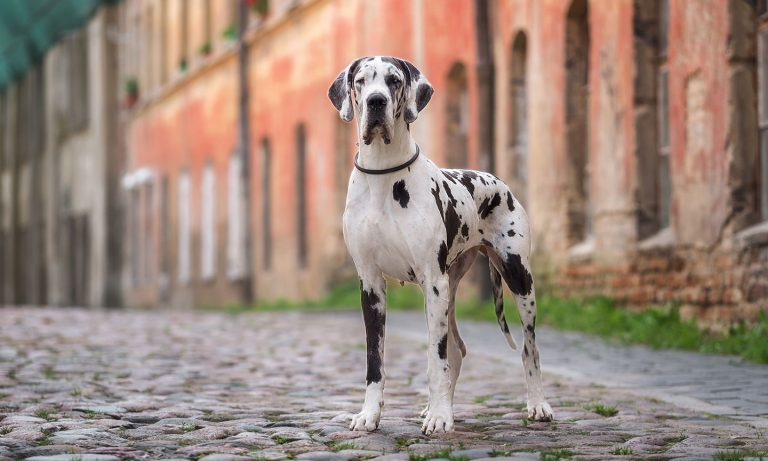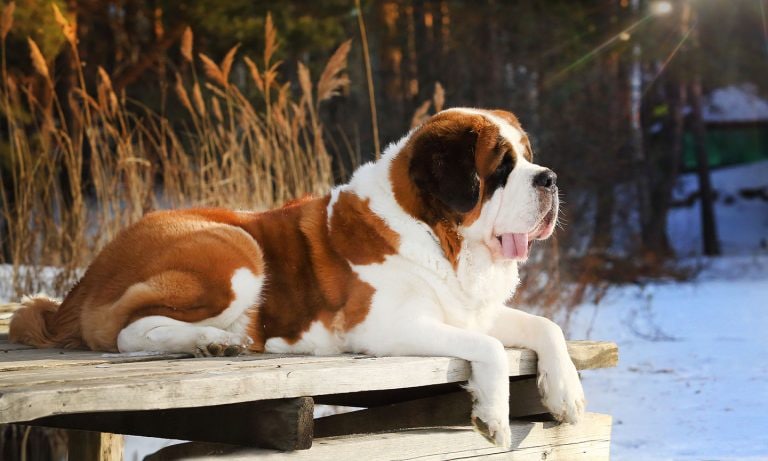Great Dane vs Saint Bernard

Breed Snapshot
Best For
Great Danes are regal, gentle giants with a calm temperament and moderate exercise needs. They make wonderful family companions, and the amount of love they have to give is as big as they are. They're...
Great Danes are regal, gentle giants with a calm temperament and moderate exercise needs. They make wonderful family companions, and the amount of love they have to give is as big as they are. They're ideal for pet parents seeking pet who's as affectionate as they are, well, huge.
Great Dane Temperament
Don’t be fooled by the breed’s large size and assume this dog has an intimidating personality to match. Great Danes are, in fact, loyal and kind with happy personalities and they desire to always be near their people. Great Danes prefer to keep you in their line of...
Don’t be fooled by the breed’s large size and assume this dog has an intimidating personality to match. Great Danes are, in fact, loyal and kind with happy personalities and they desire to always be near their people. Great Danes prefer to keep you in their line of sight, and you can forget about eating alone or cooking a meal by yourself ever again!
Great Danes can sometimes come off as shy, aloof or reserved. Socializing your Great Dane puppy at an early age will help them become more comfortable around new people and other dogs. They have a deep, powerful bark that can be intimidating to visitors, but this is a case where the bark is really worse than the bite.
The Great Dane was originally bred to be a hunting dog. Today, they mainly fill the role of “lovable family member.” And don’t be surprised if your Great Dane attempts to be a lap dog—the results can be hilarious.
Great Dane Traits

Breed Snapshot
Best For
Drooly gentle giants, Saint Bernards are best for larger homes with experienced pet parents who can provide lots of focused training and regular exercise—and keep up with their grooming needs. Known for their calm...
Drooly gentle giants, Saint Bernards are best for larger homes with experienced pet parents who can provide lots of focused training and regular exercise—and keep up with their grooming needs. Known for their calm and affectionate nature, these teddy bears are kid- and pet-friendly, to boot.
Saint Bernard Temperament
Would you ever expect your personal bodyguard to be mistaken for a floofy teddy bear? Probably not, but you should. (Because: safety first. And also because: adorable.) Saint Bernards’ gentle, calm demeanor with a dash of playfulness are a natural fit for homes with older children, other dogs and eve...
Would you ever expect your personal bodyguard to be mistaken for a floofy teddy bear? Probably not, but you should. (Because: safety first. And also because: adorable.) Saint Bernards’ gentle, calm demeanor with a dash of playfulness are a natural fit for homes with older children, other dogs and even friendly felines. They’ll also mesh with younger children, but littler kiddos will need extra supervision to ensure they can respect your pup’s boundaries.
A Saint Bernard dog doesn’t always comprehend just how big they are, which can cause some consternation and tears when playing with tipsy tots or unstable adults (or tipsy adults, for that matter). Training for both humans and the dog is a must to be sure nobody accidentally gets knocked over during backyard romps or in-home zoomies. Saints are friendly dogs (and they swear they didn’t mean to knock you down! They thought you were trying to start a game of tag!) and will stay that way with a loving home and positive reinforcement-based training. In general, Saints are not known to bite, but it’s always important to properly socialize and train any dog. Socializing your Saint Bernard puppy before 20-24 weeks of age allows your outgoing pup to learn good manners and blossom as a beloved family pet.
If it looks like you’re going to do something fun, Saints will want to join you, no questions asked. They’re in the car before you can even find your keys, ready for a nature trail adventure or a Sunday drive through the country. Whatever their human is doing, they want to mirror the activity or supervise from a cozy spot next to your feet.
If you have a job you need doing, give it to a Saint, and they will be more than happy to check it off your to-do list. Saint Bernards are a working breed who love to help people. Give them a chore, like helping feed livestock on a farm or serving as a door greeter at your small business, and they’ll be happy campers. Saints are eager to please. You’ll know the Saint Bernard is in their element when they can’t stop the drool from flowing and their tail from wagging.




